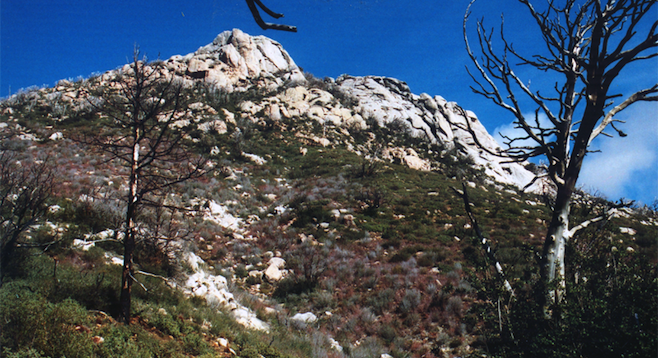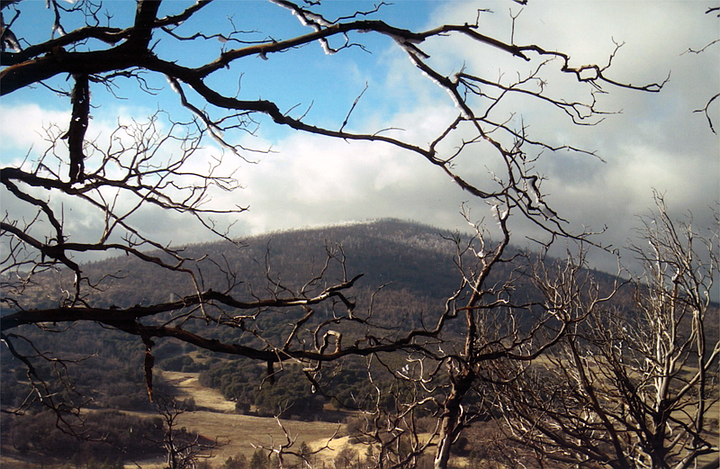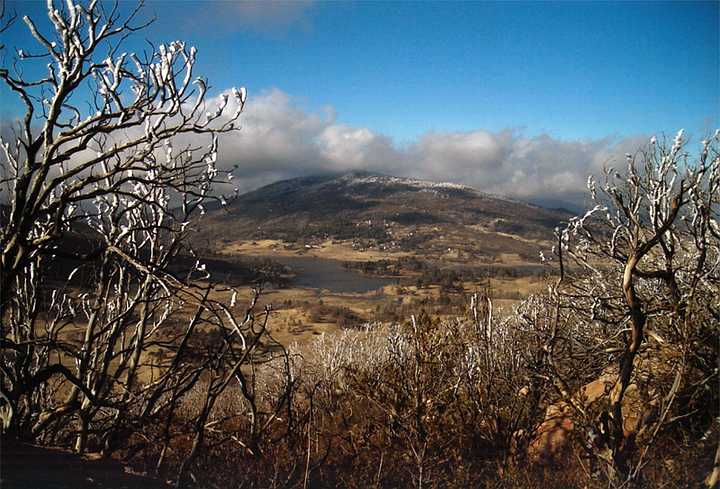 Facebook
Facebook
 X
X
 Instagram
Instagram
 TikTok
TikTok
 Youtube
Youtube

Fifty, 100, even 200 years after a historical event, you can get the feel of a place just by being there. Stand at the ruins on Presidio Hill, for example. Erase all the trees, all the buildings below, all the cars on the freeways. Then see why the first Alta California expedition of 1769 chose this spot to build their fort. It’s the most defendable high ground in the area: you can see for miles in almost every direction, from Point Loma to Mt. Soledad, far down Mission Valley, and Mexico.

And you can also feel how the near-constant winds flipped the tiles off adobe buildings, smashed them on the courtyard or the walls, and drove the Commandants nuts.
In 1837, after a band of Kumeyaay warriors burned Rancho Jamul, they herded the livestock, and two captive women, into the mountains. San Diegans paid the region’s number one hired gun, Macedonio Gonzalez to gather a force and go after them. In those days, and for years later, his first name struck terror. “For him to shoot an Indian,” wrote August Janssens, “was as easy a matter, it seemed, as taking a cup of chocolate.”
Macedonio followed the trail until he came to a box canyon, where 200 Kumeyaay warriors ambushed his party and did grave damage.
So. A box canyon in the back country, wide and tall, and obviously on a well-traveled trail.
Janssens, who was there, calls it “a narrow pass leading to the Colorado River,” and later a “defile” in the mountains.
Vicente Romero, also on the expedition: they went from “Jacum, Matacawat, Guatay, Cuyamaca Valley, and round to Valley de las Viejas” – then fought the battle at “Matadera” in the “Jacum Mountains.”
In an interview, Macedonio said he followed “age-old Indian trails,” eventually going through “Pine Valley to Guatay, and then up to Cuyamaca Valley” where the Kumeyaay had their “principal Rancheria” – village – “in a pile of rocks north of a sharp-pointed peak.”
Most conclude this was Stonewall, the 5000 foot peak due south of Lake Cuyamaca.
So did “Trusty,” my tramp-mate (aka Michael Clark), and I. When we went on this search, several years ago, we’d been batting 1.000: found everything we sought.
We went in the spring, early enough so the rattlers were still hibernating, but late enough, we figured, for the sun to warm our path.
It snowed the night before. When we stood at the foot of Stonewall, the trees and hills were white. With permission from the local rangers – none of whom could suggest a likely spot - we searched canyons on both sides of Highway 79. But they were either too narrow, too small, or too far from a former thoroughfare.

We decided to climb Stonewall Peak. Get an overview. It was early afternoon, the ground was still cold, but the snow was melting in white gobs the size of basketballs. Whole hillsides looked like a giant’s cotton fields. Before a gob hit the ground, it made a swish, as it clattered through leafless branches, then a ka-boom, exploded in all directions.
As Trusty and I started up the long, switchback trail, we heard two women shouting above us. Couldn’t make out the high-pitched words. As they came around a turn and saw us, they screamed: “Go back! Mountain lion!”
I looked at Trusty, trying to sound all voice of reason, and said, “head back?”
“Naw,” he said, stomping ice off the soles of his hiking boots, “we go on.”
(Yeah, that Trusty: one time we were looking for an old mineshaft and the trail ended. "Stops here," I said,underlining the obvious. "No it don't," said the Trustmeister, surging forward with even grimmer determination).
We didn’t get far before a male voice shouted from below.
“You guys didn’t hear? Mountain lion.”
“We did,” said Trusty, on the move.
I pointed up and/or down, like a weathervane on the blink, suggesting either way would do. When the Ranger saw Trusty trudging up the grade, he said, “Let’s check it out.”
After he gave us safety instructions – such as keep your eyes up, since the big cat most likely will pounce from above, I quoted Hamlet. “For this relief much thanks.”

Trusty led the way. I was in the middle, looking and listening hard. At almost every step we took, or so it seemed, a clump of snow whistled through the branches and thumped-splashed on the ground – just like, I was convinced, a mountain lion.
“Lions and tigers and…” No, Dorothy, just one lion, probably so famished from a long, cold, lonely winter to consider a human triple-decker, hold the secret sauce.
So instead, my mantra became, “A lion, a lion, a lion – oh my!” – “oh my!” given heartfelt emphasis every time an ice-bomb hit nearby.
At the top of Stonewall, we saw gorgeous views but no site that fit the descriptions. It will always remain the box canyon that got away.
Fortunately for us, so will the mountain lion.


Fifty, 100, even 200 years after a historical event, you can get the feel of a place just by being there. Stand at the ruins on Presidio Hill, for example. Erase all the trees, all the buildings below, all the cars on the freeways. Then see why the first Alta California expedition of 1769 chose this spot to build their fort. It’s the most defendable high ground in the area: you can see for miles in almost every direction, from Point Loma to Mt. Soledad, far down Mission Valley, and Mexico.

And you can also feel how the near-constant winds flipped the tiles off adobe buildings, smashed them on the courtyard or the walls, and drove the Commandants nuts.
In 1837, after a band of Kumeyaay warriors burned Rancho Jamul, they herded the livestock, and two captive women, into the mountains. San Diegans paid the region’s number one hired gun, Macedonio Gonzalez to gather a force and go after them. In those days, and for years later, his first name struck terror. “For him to shoot an Indian,” wrote August Janssens, “was as easy a matter, it seemed, as taking a cup of chocolate.”
Macedonio followed the trail until he came to a box canyon, where 200 Kumeyaay warriors ambushed his party and did grave damage.
So. A box canyon in the back country, wide and tall, and obviously on a well-traveled trail.
Janssens, who was there, calls it “a narrow pass leading to the Colorado River,” and later a “defile” in the mountains.
Vicente Romero, also on the expedition: they went from “Jacum, Matacawat, Guatay, Cuyamaca Valley, and round to Valley de las Viejas” – then fought the battle at “Matadera” in the “Jacum Mountains.”
In an interview, Macedonio said he followed “age-old Indian trails,” eventually going through “Pine Valley to Guatay, and then up to Cuyamaca Valley” where the Kumeyaay had their “principal Rancheria” – village – “in a pile of rocks north of a sharp-pointed peak.”
Most conclude this was Stonewall, the 5000 foot peak due south of Lake Cuyamaca.
So did “Trusty,” my tramp-mate (aka Michael Clark), and I. When we went on this search, several years ago, we’d been batting 1.000: found everything we sought.
We went in the spring, early enough so the rattlers were still hibernating, but late enough, we figured, for the sun to warm our path.
It snowed the night before. When we stood at the foot of Stonewall, the trees and hills were white. With permission from the local rangers – none of whom could suggest a likely spot - we searched canyons on both sides of Highway 79. But they were either too narrow, too small, or too far from a former thoroughfare.

We decided to climb Stonewall Peak. Get an overview. It was early afternoon, the ground was still cold, but the snow was melting in white gobs the size of basketballs. Whole hillsides looked like a giant’s cotton fields. Before a gob hit the ground, it made a swish, as it clattered through leafless branches, then a ka-boom, exploded in all directions.
As Trusty and I started up the long, switchback trail, we heard two women shouting above us. Couldn’t make out the high-pitched words. As they came around a turn and saw us, they screamed: “Go back! Mountain lion!”
I looked at Trusty, trying to sound all voice of reason, and said, “head back?”
“Naw,” he said, stomping ice off the soles of his hiking boots, “we go on.”
(Yeah, that Trusty: one time we were looking for an old mineshaft and the trail ended. "Stops here," I said,underlining the obvious. "No it don't," said the Trustmeister, surging forward with even grimmer determination).
We didn’t get far before a male voice shouted from below.
“You guys didn’t hear? Mountain lion.”
“We did,” said Trusty, on the move.
I pointed up and/or down, like a weathervane on the blink, suggesting either way would do. When the Ranger saw Trusty trudging up the grade, he said, “Let’s check it out.”
After he gave us safety instructions – such as keep your eyes up, since the big cat most likely will pounce from above, I quoted Hamlet. “For this relief much thanks.”

Trusty led the way. I was in the middle, looking and listening hard. At almost every step we took, or so it seemed, a clump of snow whistled through the branches and thumped-splashed on the ground – just like, I was convinced, a mountain lion.
“Lions and tigers and…” No, Dorothy, just one lion, probably so famished from a long, cold, lonely winter to consider a human triple-decker, hold the secret sauce.
So instead, my mantra became, “A lion, a lion, a lion – oh my!” – “oh my!” given heartfelt emphasis every time an ice-bomb hit nearby.
At the top of Stonewall, we saw gorgeous views but no site that fit the descriptions. It will always remain the box canyon that got away.
Fortunately for us, so will the mountain lion.
Comments